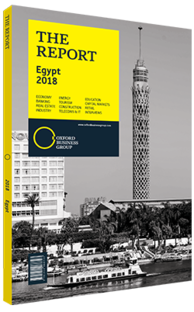Egyptian textiles rebound and see new growth
With a renewed focus on growing quality cotton crops (see Agriculture chapter), Egypt’s textiles industry is experiencing a revival. The Ministry of Trade and Industry (MTI) points to textiles as one of the industries helping to shift Egypt’s trade balance in 2017, with exports increasing by around 12% and imports declining by 59%. Tarek Kabil, minister of trade and industry, noted that in 2017 the textiles industry contributed 3% to GDP, employed about one-third of the industrial labour force and provided annual exports worth around $2.6bn, accounting for 15% of all non-petroleum exports. By September 2017 garment exports had reached $941m for the year, compared to $865m in the same period in 2016, according to the Readymade Garments Export Council of Egypt. A 2016 report from global bank HSBC notes that there are over 4000 companies operating across the country, with 196 in free zones.
Mohamed Maher, vice-chairman and CEO of local investment bank Prime Holding, told OBG, “Any labour-intensive industries, including textile production, which used to be a dying industry, now have a good chance with improved labour costs and technologies to help to start a new era of production, both for the big local market and exports.”
Government Support
The state is working on policy initiatives to boost the local textiles industry. In July 2017 Kabil, along with Abdel Moneim El Banna, the minister of agriculture, signed a two-year, $1.72m protocol with the UN Industrial Development Organisation and the Italian Agency for Development Cooperation to increase the added value of Egyptian cotton. The agreement includes capacity-building training for 400 cotton farmers, workers and students at 15 textile companies. In September 2017 the MTI announced it was preparing a national strategy for textiles, spinning and ready-made clothing.
In January 2018 the MTI announced plans to develop Egypt’s biggest textiles city in Sadat, with capital of $2bn to be paid over seven years. The first of five implementation phases is expected to begin in March 2018, with the project to be completed by 2024.
International Partnerships
The US remains the most popular export destination for Egyptian textiles, receiving 53.5% of ready-made garments, followed by the EU, with 31.7%, according to the General Organisation for Export and Import Control. In the first eight months of 2017 exports to the US reached $461m, compared to $436m in the same period in 2016. Textile exports to the EU, the Arab world and Africa all increased throughout 2017 as well.
Part of the reason why the US is such a popular destination is because of Egypt’s Qualified Industrial Zone (QIZ) programme, which allows products manufactured in an Egyptian QIZ to be exported to the US at a tariff rate of zero. According to the US Agency for International Development, the textile and clothing industry has taken the greatest advantage of the programme, exporting more than $800m worth of woven and knitted clothing to the US in 2014. In 2011 over 95% of Egypt’s QIZ exports consisted of garments and linens, though this declined to 88% by 2014.
There has also been interest in textiles from new partners. In May 2017 the MTI announced that Chinese textile company Shandong Ruyi Technology was in the study phase of building an $800m textile and ready-made garment industrial complex. During the four-day Cairo Fashion and Tex Exhibition, which took place in September 2017, several Indian companies announced plans to increase collaboration with Egypt in textiles, with talks of increasing the provision of Indian-manufactured textile machinery supplies.
As the government refocuses on textiles, particularly on quality cotton production, the industry is primed to become an even more important player in exports. Egypt’s proximity to the EU, as well as to Africa and the MENA region, provide strategic, unsaturated markets for quality and competitively priced products.
You have reached the limit of premium articles you can view for free.
Choose from the options below to purchase print or digital editions of our Reports. You can also purchase a website subscription giving you unlimited access to all of our Reports online for 12 months.
If you have already purchased this Report or have a website subscription, please login to continue.

